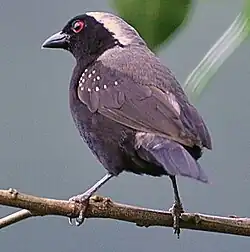Grey-headed nigrita
| Grey-headed nigrita | |
|---|---|

| |
| Scientific classification | |
| Kingdom: | Animalia |
| Phylum: | Chordata |
| Class: | Aves |
| Order: | Passeriformes |
| Family: | Estrildidae |
| Genus: | Nigrita |
| Species: | N. canicapillus
|
| Binomial name | |
| Nigrita canicapillus (Strickland, 1841)
| |
The grey-headed nigrita (Nigrita canicapillus) is a common species of estrildid finch found in Africa. It has an estimated global extent of occurrence of 3,700,000 km2.
It is widespread throughout the African tropical rainforest.
The status of the species is evaluated as Least Concern.
Taxonomy
The grey-headed nigrita was formally described in 1841 by the English naturalist Hugh Edwin Strickland based on a specimen collected on the island of Bioko (formerly named Fernando Pó), off the west coast of Africa. He coined the binomial name Aethiops canicapillus[2][3] where the specific epithet combines the Latin canus meaning "grey" with -capillus meaning "-capped" or "-headed".[4] The grey-headed nigrita is now one of four species placed in the genus Nigrita that was introduced in 1843 by Strickland.[5]
Six subspecies are recognised:[5]
- N. c. emiliae Sharpe, 1869 – Guinea and Sierra Leone to Togo
- N. c. canicapillus (Strickland, 1841) – south Benin and south Nigeria to central DR Congo and Gabon
- N. c. schistaceus Sharpe, 1891 – south Sudan and east DR Congo to west Kenya and north Tanzania
- N. c. angolensis Bannerman, 1921 – northwest Angola and south DR Congo
- N. c. diabolicus (Reichenow & Neumann, 1895) – central Kenya to north Tanzania
- N. c. candidus Moreau, 1942 – west Tanzania
References
- ^ BirdLife International (2018). "Nigrita canicapillus". IUCN Red List of Threatened Species. 2018: e.T22719298A132127206. doi:10.2305/IUCN.UK.2018-2.RLTS.T22719298A132127206.en. Retrieved 12 November 2021.
- ^ Strickland, Hugh Edwin (1841). "On some new genera of birds". Proceedings of the Zoological Society of London. 9 (99): 27-34 [30].
- ^ Paynter, Raymond A. Jr, ed. (1968). Check-List of Birds of the World. Vol. 14. Cambridge, Massachusetts: Museum of Comparative Zoology. p. 310.
- ^ Jobling, James A. "canicapillus". The Key to Scientific Names. Cornell Lab of Ornithology. Retrieved 14 August 2025.
- ^ a b Gill, Frank; Donsker, David; Rasmussen, Pamela, eds. (February 2025). "Waxbills, parrotfinches, munias, whydahs, Olive Warbler, accentors, pipits". IOC World Bird List Version 15.1. International Ornithologists' Union. Retrieved 14 August 2025.
